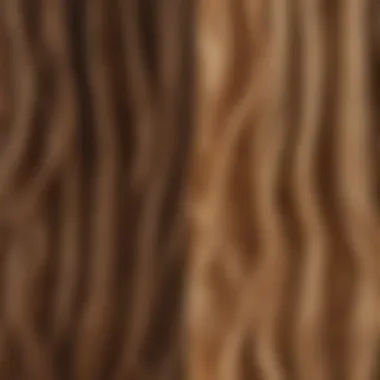Understanding Split Ends: Causes and Solutions


Intro
Split ends are a common issue that many women encounter throughout their lives. Understanding them requires familiarity with various factors contributing to hair damage. This knowledge is crucial as split ends not only affect the hair's appearance but can also lead to further breakage and loss if not addressed.
In this article, we will explore the underlying causes of split ends, effective prevention strategies, and scientifically-backed solutions. While popular culture often presents split ends as merely a cosmetic problem, they signify deeper hair health issues. This guide aims to dispel myths and equip readers with actionable advice for maintaining healthy hair.
A variety of factors play into why split ends develop. These include environmental influences, hair care routines, and even dietary habits. Each person’s hair is unique, requiring tailored approaches for effective care. Therefore, we will delve into methods of prevention, suitable products for treatment, and lifestyle changes that can promote hair health.
By the end of this article, readers will gain an insightful perspective on managing split ends effectively and, perhaps more importantly, nurturing the hair’s overall health.
Defining Split Ends
Understanding what split ends are is foundational for any discussion about hair care. Split ends, also known as trichoptilosis, occur when the protective outer layer of the hair cuticle becomes shattered or worn away. This leads to splitting, fraying, or simply the deterioration of the hair shaft’s integrity. By defining split ends, we recognize their implications for the overall health of hair, and this acknowledgment shapes our approaches to care and prevention.
What Are Split Ends?
Split ends refer to the separation of the hair's shaft into two or more strands. While it is a common issue experienced by many, particularly those with longer hair, it can also hint at deeper problems regarding the health of hair itself. Making a distinction between normal wear and serious damage is imperative. Factors such as genetic predisposition, care routines, and lifestyle choices largely contribute to this phenomenon. An increased presence of split ends can hinder the appearance of hair, leading to dullness or lack of shine. Recognizing split ends early can facilitate timely intervention and guideline adherence.
The Anatomy of Hair
To thoroughly understand split ends, we must explore the anatomy of hair. Each strand comprises three primary layers: the cuticle, cortex, and medulla.
- Cuticle: This outer layer consists of tiny overlapping cells that protect the inner layers. When intact, the cuticle ensures the hair remains smooth and shiny. If damaged, the hair becomes prone to splitting and fraying.
- Cortex: Situated beneath the cuticle, the cortex provides strength and elasticity. It contains fibrous proteins, which make up most of the hair’s mass. A compromised cortex can result in a weak strand, amplifying the chances of split ends.
- Medulla: This innermost layer is less significant in the average hair strand. Its presence varies, and it does not typically affect split ends directly but contributes to hair's overall structure.
Recognizing this structure is crucial in understanding how split ends develop and how care methods can be tailored to combat them. Identifying the causes rooted in this anatomy allows for more effective preventive measures, promoting healthier hair overall.
Common Causes of Split Ends
The presence of split ends can be frustrating for many, especially for those aiming for healthy, beautiful hair. Understanding the common causes of split ends is vital for anyone looking to maintain hair health. By identifying these causes, individuals can implement targeted strategies to prevent further damage, ultimately leading to stronger, more resilient hair.
Environmental Factors
Environmental conditions play a significant role in the health of hair. Factors such as sun exposure, humidity, and pollution can contribute to the deterioration of hair strands. UV rays from the sun can weaken hair proteins, making them more susceptible to breakage. Additionally, high humidity can lead to frizz and tangling, which increases the likelihood of split ends.
To protect hair from these elements, consider wearing a hat on sunny days and using hair products that provide UV protection. Regular cleansing to remove dirt and pollutants is also essential.
Chemical Treatments
Chemical treatments, such as coloring, perming, and relaxing, can exert considerable stress on hair. These processes often strip natural oils, making hair more vulnerable to damage. When over-processed, hair loses its elasticity, leading to an increased risk of split ends and overall brittleness.
It is crucial to choose high-quality products and to seek professional help when undergoing chemical treatments. Additionally, follow the treatment with appropriate conditioning and moisturizing products to help mitigate damage.
Heat Styling Tools
Many people rely on heat styling tools, such as flat irons and curling wands, for various hairstyles. However, excessive heat can weaken hair and lead to split ends. The high temperatures can cause moisture loss, leading to dryness and breakage.
To minimize heat damage, reduce the frequency of heat styling and always apply a heat protectant before using these tools. Opt for lower temperature settings when possible and allow hair to air dry occasionally to preserve its natural structure.
Lack of Proper Care
A strong hair care regimen is critical to maintaining healthy hair. Neglecting proper care can result in a lack of moisture, dirt buildup, and neglect for the overall health of the hair, all of which contribute to split ends. Regular cleansing, conditioning, and moisturizing are essential steps in any hair care routine.
Investing time in finding the right products for your hair type and establishing a consistent routine will lead to noticeable improvements. Keeping hair well-nourished can significantly reduce the incidence of split ends, ensuring that hair stays vibrant and healthy over time.
Myths Surrounding Split Ends
Understanding the myths surrounding split ends is crucial. Misconceptions can lead to ineffective care routines, ultimately harming your hair. This section aims to clarify significant myths and provide insight into the reality of hair care. It's important that women recognize what truly helps in avoiding and treating split ends, fostering proper hair health.
The Myth of Hair Trimming


A common belief is that frequent trims prevent split ends. While trimming does remove split ends from the hair, it doesn't prevent new ones from forming. Many think that trimming every few weeks will solve the problem, but hair health is influenced by caring habits and level of damage, not just cutting.
Key Points:
- Regular Trimming: Cuts only address current damage. They do not inherently improve hair's resistance to splitting.
- False Security: Relying solely on trims may lead to neglect in proper hydration and treatment of the hair strands.
- Individual Variation: Hair types and their unique needs must be considered. What might work for one person does not necessarily work for another.
To maintain a healthy look, focus on a comprehensive hair care routine instead of depending on frequent haircuts.
Oil Treatments and Their Effectiveness
Oil treatments are often marketed as miracle solutions for split ends. While they can enhance moisture and shine, their value is misunderstood.
Important Insights:
- Surface-Level Treatment: Oils provide a temporary polish to hair and may mask damage without healing it.
- Variety of Oils: Different oils have distinct properties. For instance, coconut oil can penetrate the hair shaft, while argan oil mainly coats the hair cuticle.
- Misguided Application: Applying too much oil can lead to build-up, weighing down the hair and potentially leading to more damage, rather than protecting against split ends.
It's vital to understand that oil treatments are not a standalone fix. They should be part of a larger strategy that includes proper cleansing and conditioning, along with a balanced diet for overall hair health.
Takeaway: Myths create barriers to effective hair care. Recognizing the truth about hair trims and oil applications can lead to better choices and healthier hair overall.
Preventive Measures for Split Ends
Preventive measures for split ends are crucial in maintaining hair health. While it is impossible to completely eradicate split ends, implementing effective strategies can significantly reduce their occurrence. These measures promote healthier hair, ensuring that hair remains strong and vibrant over time. In this section, we will discuss hydration strategies, choosing the right products, limiting heat exposure, and incorporating protective styles into your hair care routine.
Hydration Strategies
Proper hydration is vital for hair health. Hydrated hair tends to be more resilient and less prone to damage. Here are some strategies that can help:
- Drink Plenty of Water: Ensure to consume adequate water daily. This keeps your hair follicles nourished and supports overall hydration.
- Use Moisturizing Products: Opt for shampoos and conditioners specifically designed to hydrate hair. Ingredients like glycerin and natural oils can retain moisture effectively.
- Deep Conditioning Treatments: Incorporate deep conditioning into your weekly routine. This provides intense moisture, making hair softer and more manageable.
A well-hydrated mane is less likely to split, making hydration a core aspect of your hair care regimen.
Choosing the Right Products
Selecting suitable hair care products is essential in preventing split ends. Not every product is designed for all hair types. Focus on the following elements:
- Avoid Harsh Chemicals: Stay away from products containing sulfates and parabens, as these can strip hair of moisture and cause brittleness.
- Prioritize Quality Ingredients: Look for products with nourishing ingredients such as shea butter, aloe vera, or argan oil. These components can help enhance hair health.
- Tailor to Your Hair Type: Identify your hair type—whether wavy, curly, or straight—and match products accordingly. Using the wrong product can lead to further damage.
Informed choices in product selection can greatly diminish the chances of developing split ends.
Limit Heat Exposure
Heat styling tools are notorious for causing damage to hair. Limiting exposure helps maintain the integrity of your locks:
- Reduce Use of Hair Dryers and Curling Irons: Allow hair to air-dry whenever possible. When using heat tools, ensure they are on the lowest effective setting.
- Use Heat Protectants: If you must style with heat, apply a heat-protectant spray. This acts as a barrier, safeguarding hair from the damaging effects of high temperatures.
- Adopt Heat-Free Styles: Try heat-free hairstyles that maintain the beauty of your hair without risking damage.
By limiting heat exposure, you can significantly decrease the risk of developing split ends.
Protective Styles
Protective hairstyles are beneficial in reducing wear and tear on hair. These styles help shield hair from environmental factors and daily manipulation:
- Braids and Twists: Simple braids or twists can protect the ends of your hair from splits. They keep the hair bundled and reduce friction.
- Updos and Buns: Styles that keep hair off your shoulders can prevent rubbing against clothing, which can lead to split ends.
- Wigs and Hairpieces: Occasionally wearing wigs can give your hair a break from styling products and environmental damage.
Incorporating protective styles into your routine can be an effective measure against split ends.
Conclusion: Integrating these preventive measures into your hair care routine can lead to healthier hair and a reduction in split ends. Each small change contributes to the overall strength and beauty of your hair.
Effective Treatments for Existing Split Ends
Split ends are a common issue faced by many individuals, especially women seeking to maintain healthy hair. Understanding effective treatments is crucial not only as a remedy for existing damage but also as part of a comprehensive hair care strategy. Effective treatments help to mitigate further splitting, improve manageability, and create a more polished appearance.


It is important to consider that while treatments can improve the condition of split ends, they cannot permanently fix damaged hair. Regular maintenance and a combination of treatments can provide significant benefits. This can lead to shinier, softer, and healthier hair. It is essential to incorporate these treatments into your routine for optimum results.
Conditioning Treatments
Conditioning treatments play a vital role in treating split ends. These treatments work to restore moisture to the hair, making it more flexible and less prone to breakage. When choosing a conditioner, look for products that contain ingredients like argan oil or shea butter, which are known for their hydrating properties.
To apply a conditioning treatment effectively:
- Choose the right product: Select a deep-conditioning mask or treatment designed specifically for dry or damaged hair.
- Apply generously: Distribute the product evenly, focusing on the ends of your hair where the damage is most prevalent.
- Allow time: Let the conditioner sit for an adequate amount of time, usually between 10 to 30 minutes, to allow it to penetrate.
- Rinse thoroughly: Ensure all product is removed to avoid buildup that may lead to further damage.
Regular use of conditioning treatments every week can dramatically reduce the appearance of split ends while also improving the overall health of your hair.
Hair Masks and Remedies
Hair masks serve as a deep treatment option that can nourish and repair split ends. These masks are typically more concentrated than regular conditioners. They can provide intensive hydration and work to seal the hair cuticle. You can either purchase specialized hair masks or create your own using natural ingredients.
Some effective ingredients to consider include:
- Coconut oil: Known for its ability to penetrate the hair shaft, providing moisture and reducing protein loss.
- Honey: A natural humectant that draws moisture into the hair, resulting in increased shine and softness.
- Avocado: Packed with fatty acids and vitamins, helping to give your hair the nourishment it needs.
Applying a hair mask requires a similar approach to conditioning treatments. Use it once a week to see improved results over time.
"Treating hair with masks and natural remedies has shown significant benefits for those with damaged locks, reducing further issues."
Professional Treatments
For those seeking immediate and effective solutions, professional treatments can offer targeted care for existing split ends. Salons often provide options such as keratin treatments, deep conditioning services, and hair bonding treatments. These procedures may use advanced technology and professional products that are not available in regular stores.
When considering professional treatments:
- Consult a stylist: They can assess your hair’s condition and recommend the best treatment tailored to your needs.
- Be cautious of over-treatment: Regular chemical treatments can lead to further damage, so it is vital to discuss the frequency and types of treatments with your stylist.
- Inquire about products used: Knowing what products your stylist uses can help you replicate some of the benefits at home.
These professional solutions can substantially improve the health and appearance of your hair, making it look vibrant and more manageable.
By focusing on these effective treatments for existing split ends, you can begin the journey toward healthier hair. Maintaining split ends requires a combination of at-home care and professional intervention. The right treatments can prevent further damage and facilitate better hair health overall.
The Role of Nutrition in Hair Health
Nutrition plays a crucial role in maintaining the overall health of hair. It influences hair growth, strength, and appearance. A well-nourished body can produce healthy hair strands less susceptible to damage. This section will delve into the essential vitamins and hydration's impact on hair health, emphasizing that what you consume significantly affects how your hair looks and feels.
Essential Vitamins
Certain vitamins are vital for promoting hair health. These include:
- Vitamin A: Essential for cell growth, Vitamin A also aids in producing sebum, which keeps hair moisturized.
- Vitamin C: Acts as an antioxidant, protecting hair follicles from damage. It also supports collagen production, which is important for hair structure.
- Vitamin D: Linked to hair follicle cycling. Low levels may be associated with hair loss.
- B-Vitamins: Particularly biotin, B6, and B12 are known for their influence on hair health. Biotin is often linked to increased hair growth and strength.
- Vitamin E: Another powerful antioxidant. It may enhance blood circulation to the scalp, improving hair growth.
Integrating foods rich in these vitamins into your diet can enhance hair quality. For instance, leafy greens, nuts, seeds, and fruits should be regular parts of meals. Consider discussing dietary changes with a health professional for personalized advice.
Hydration and Its Impact
Hydration is another critical element affecting hair health. Good hydration keeps hair soft and prevents brittleness. When the body lacks adequate fluids, hair strands may become dry and prone to splitting.
- Drinking Water: Ensuring sufficient water intake can directly benefit hair health. Aim for at least eight glasses of water daily, adjusting for individual needs.
- Washing Practices: While washing hair, use lukewarm water instead of hot water. This helps retain moisture without stripping natural oils.
- Humid Environments: In dry climates, consider using a humidifier to help maintain moisture in the air. This can significantly reduce hair dehydration.
"Hydration is not just about drinking water; it's about how hair absorbs and retains moisture."
In summary, understanding the role of nutrition, especially vitamins and hydration, can help manage hair health effectively. Proper intake and care routines can reduce the likelihood of split ends and contribute to the overall well-being of your hair.
Understanding Different Hair Types
Understanding different hair types is crucial for effective hair care, especially when dealing with issues like split ends. Each hair type has unique characteristics that influence how it responds to products, styling techniques, and environmental factors. By grasping these distinctions, individuals can tailor their hair care routines to better suit their specific needs. This creates a more personalized approach to preventing split ends and enhancing overall hair health.


Wavy and Curly Hair
Wavy and curly hair typically exhibits a unique texture that can contribute to split ends if not properly cared for. This hair type is generally drier due to its structure, which makes it more prone to damage. The curls and waves can cause tangling, leading to breakage and split ends when brushes or combs are used roughly.
To manage wavy and curly hair effectively, consider the following:
- Moisture Retention: Use moisturizing products that drown the hair in hydration, as curly hair often lacks moisture.
- Gentle Detangling: Employ wide-tooth combs or fingers for detangling when the hair is wet, as this can minimize breakage.
- Regular Trims: Schedule trims every few months to remove split ends and promote healthier growth.
Proper care can lead to well-maintained curls or waves. Protecting your hair from heat and environmental stressors is also vital.
Straight Hair
Straight hair, while often easier to manage, is not exempt from split ends. The shine and smooth texture can make damage less noticeable, but this does not mean it is immune. Straight hair can become brittle and prone to splitting due to excessive use of heat styling tools or chemical treatments.
To keep straight hair in optimal condition, it is important to:
- Limit Heat Usage: Instead of daily heat styling, consider alternatives like air drying or braiding for waves.
- Sulfate-Free Products: Opt for sulfate-free shampoos and conditioners to maintain natural oils and prevent drying out.
- Protective Styles: Use protective hairstyles that minimize hair exposure to external damage.
By understanding your hair type, you make informed choices in your hair care products and routine. This proactive approach is essential for preventing split ends and fostering healthier hair overall.
"Personalized hair care can transform not just the look but the health of your hair."
Adopting these strategies allows one to cater to the distinct needs of straight hair, resulting in stronger and healthier strands.
Long-term Hair Care Routines
Long-term hair care routines are essential for maintaining healthy hair and minimizing the occurrence of split ends. A consistent approach not only reinforces the hair's structure but also enhances its overall appearance. By adopting a thorough regimen, individuals can address potential issues before they escalate. This proactive stance is particularly important for those who frequently style or treat their hair chemically.
Specific Elements of a Routine
A comprehensive hair care routine includes several components:
- Cleansing: Use a gentle cleanser suitable for your hair type to avoid stripping essential oils.
- Conditioning: Incorporate deep conditioners and leave-in products to maintain moisture and shine.
- Protective Measures: Employ protective hairstyles and minimize exposure to harsh environmental factors.
- Nutritional Support: Focus on a diet rich in vitamins and minerals that promote hair health, such as biotin, omega-3 fatty acids, and proteins.
Benefits of a Consistent Routine
A long-term commitment to hair care can yield significant benefits:
- Reduced Split Ends: By regularly nourishing and protecting hair, the likelihood of developing split ends decreases.
- Improved Texture: Healthy strands exhibit better texture and manageability, making styling easier.
- Enhanced Growth: A solid routine stimulates healthy hair growth, which is beneficial for those aiming to grow longer locks.
Care is required with product selections and usage frequency. Too much product or incorrect types can lead to buildup, which may cause wear and tear on hair strands.
Establishing a Routine
Establishing a hair care routine is not merely about choosing products; it involves creating a framework based on your specific hair type and lifestyle. Recognize your hair’s unique needs, whether it’s dry, oily, or chemically treated. Understanding these factors helps in picking the right items and methods.
Start by scheduling regular wash days. For many, washing hair two to three times a week is often sufficient. Include conditioning treatments, which should be adapted to the seasons, as environmental factors can play a role in hair health. For instance, hydration may need to be stepped up in winter months when the air is dry.
Implement a weekly hair mask routine. This can fortify hair and restore moisture. A mix of natural ingredients like coconut oil and honey can be effective—natural components often yield positive results.
Track Your Progress
Tracking progress in your hair care journey helps to measure effectiveness and tailor future routines. This can be quite simple and doesn't require elaborate systems.
Keeping a Hair Journal
Maintain a record of products used, treatments applied, and any changes observed. Note how your hair responds to various products and which methods contribute to better health.
Regular Assessments
Check your hair’s condition monthly. Look for signs of split ends or dryness. If problems recur, reconsider product choices or application methods. Adjust frequency of washes or treatments based on what your hair appears to need at that time.
"Adopting a tracking method not only keeps you accountable but also empowers you to understand your hair’s needs. Knowledge is the first step to achieving and maintaining healthy hair."
Ultimately, a commitment to hair care, through consistent routines and vigilant monitoring, can lead to lasting benefits. Creating awareness about what works for your unique hair type fosters a bond between you and your hair, resulting in healthier, stronger strands.
Ending
In the realm of hair care, understanding split ends is essential for maintaining both the aesthetic and health of one’s hair. This article has taken a deep dive into split ends, highlighting their causes, prevention strategies, and effective treatments. Recognizing the multifaceted nature of split ends allows individuals to approach their hair care routines with a more informed perspective.
Recap of Key Points
To summarize, split ends occur due to a variety of factors, including exposure to environmental elements, chemical treatments, and the habitual use of heat styling tools. Proper hydration and choosing the right products can help prevent split ends from forming. Additionally, dismissing myths, such as the idea that trimming hair prevents split ends, enables a clearer understanding of how hair health is truly maintained.
"Knowledge is power. Understanding the causes of split ends empowers individuals to take proactive steps in their hair care routine."



